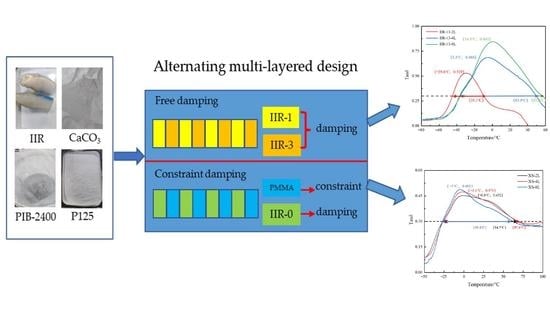Influence of Alternating Multi-Layered Design on Damping Characteristics of Butyl Rubber Composites and a New Idea for Achieving Wide Temperature Range and High Damping Performance
Abstract
1. Introduction
2. Materials and Methods
2.1. Materials
2.2. Instruments and Characterization
2.3. Sample Preparation
2.3.1. Preparation of Modified IIR
2.3.2. Preparation of Alternating Multi-Layered Structure
3. Results and Discussion
3.1. Dynamic Mechanical Properties of IIR-0/IIR-1/IIR-2/IIR-3
3.2. Effect of Alternate Layered Design on Free Damping
3.3. Effect of Alternate Layered Design on Micro-Constrained Damping
3.4. Different Methods for Broadening the Damping Temperature Range and Improving the Damping Loss Factor
3.4.1. Alternating Layered Design of Low/High-Temperature Rubber Free Damping
3.4.2. Alternating Layered Design of Wide Temperature Range Rubber/Plastics with Micro-Constrained Damping
4. Conclusions
- (1)
- Low-temperature rubber (IIR-1, −50.6 °C~23.5 °C, tanδ > 0.3), medium-temperature rubber (IIR-2, −25.1 °C~45.3 °C, tanδ > 0.3) and high-temperature rubber (IIR-3, 20.1 °C~92 °C, tanδ > 0.3) with a relatively same temperature range (72 ± 2 °C) are prepared by adjusting the content of P125 petroleum resin. A wide-temperature-range rubber (IIR-0, −33 °C~54.8 °C, tanδ > 0.3) is prepared by damping modification of butyl rubber with expanded graphite.
- (2)
- For the alternating multi-layered micro-constrained damping, the loss factor of the 8-layered composites is 2.21 times higher than that of the 2-layered composites. While for the alternating multi-layered free damping, the loss factor of the 8-layered composites is 1.6 times higher than that of the 2-layered composites. Alternating multi-layered design can improve the damping loss factor of composites.
- (3)
- The alternating multi-layered free damping has a loss factor of 0.845 and a temperature range of 93.2 °C, while the alternating multi-layered constrained damping has a loss factor of 0.488 and a temperature range of 89.4 °C. It is effective and feasible to obtain high damping and wide temperature range by first preparing damping materials with a wide temperature range, and then improving the damping peak based on micro-constrained alternating layered design.
Author Contributions
Funding
Institutional Review Board Statement
Data Availability Statement
Conflicts of Interest
References
- Ammineni, S.P.; Nagaraju, C.; Raju, D.L. Modal performance degradation of naturally aged NBR. Polym. Test. 2022, 115, 107710. [Google Scholar] [CrossRef]
- Cui, H.W.; Jing, Q.; Li, D.W.; Zhuang, T.T.; Gao, Y.X.; Ran, X.H. Study on the high-temperature damping properties of silicone rubber modified by boron-terminated polysiloxane. J. Appl. Polym. Sci. 2023, 140, e53262. [Google Scholar] [CrossRef]
- Chen, B.W.; Dai, J.W.; Song, T.S.; Guan, Q.S. Research and Development of High-Performance High-Damping Rubber Materials for High-Damping Rubber Isolation Bearings: A Review. Polymers 2022, 14, 2427. [Google Scholar] [CrossRef] [PubMed]
- Suresh, K.I.; Sitaramam, B.S.; Raju, K. Effect of copolymer composition on the dynamic mechanical and thermal behaviour of butyl acrylate-acrylonitrile copolymers. Macromol. Mater. Eng. 2003, 288, 980–988. [Google Scholar] [CrossRef]
- Patri, M.; Reddy, C.V.; Narasimhan, C.; Samui, A.B. Sequential interpenetrating polymer network based on styrene butadiene rubber and polyalkyl methacrylates. J. Appl. Polym. Sci. 2007, 103, 1120–1126. [Google Scholar] [CrossRef]
- Lei, T.; Zhang, Y.W.; Kuang, D.L.; Yang, Y.R. Preparation and Properties of Rubber Blends for High-Damping-Isolation Bearings. Polymers 2019, 11, 1374. [Google Scholar] [CrossRef]
- Liang, J.Y.; Chang, S.Q.; Feng, N. Effect of C5 petroleum resin content on damping behavior, morphology, and mechanical properties of BIIR/BR vulcanizates. J. Appl. Polym. Sci. 2013, 130, 510–515. [Google Scholar] [CrossRef]
- Wu, C.Y.; Wu, G.Z.; Wu, C.F. Dynamic mechanical properties in blends of poly(styrene-b-isoprene-b-styrene) with aromatic hydrocarbon resin. J. Appl. Polym. Sci. 2006, 102, 4157–4164. [Google Scholar] [CrossRef]
- Wan, S.H.; Zhou, S.S.; Huang, X.; Chen, S.B.; Cai, S.W.; He, X.R.; Zhang, R. Effect of Aromatic Petroleum Resin on Damping Properties of Polybutyl Methacrylate. Polymers 2020, 12, 543. [Google Scholar] [CrossRef]
- Zhao, X.-Y.; Cao, Y.-J.; Zou, H.; Li, J.; Zhang, L.-Q. Structure and dynamic properties of nitrile-butadiene rubber/hindered phenol composites. J. Appl. Polym. Sci. 2012, 123, 3696–3702. [Google Scholar] [CrossRef]
- Wang, X.; Chen, X.; Song, M.; Wang, Q.; Zheng, W.; Song, H.; Fan, Z.; Myat Thu, A. Effects of Hindered Phenol Organic Molecules on Enhancing Thermo-Oxidative Resistance and Damping Capacity for Nitrile Butadiene Rubber: Insights from Experiments and Molecular Simulation. Ind. Eng. Chem. Res. 2020, 59, 11494–11504. [Google Scholar] [CrossRef]
- Kongsinlark, A.; Rempel, G.L.; Prasassarakich, P. Synthesis of monodispersed polyisoprene-silica nanoparticles via differential microemulsion polymerization and mechanical properties of polyisoprene nanocomposite. Chem. Eng. J. 2012, 193, 215–226. [Google Scholar] [CrossRef]
- Li, C.; Wu, G.; Xiao, F.; Wu, C. Damping behavior of sandwich beam laminated with CHR/petroleum resins blends by DMA measurement. J. Appl. Polym. Sci. 2007, 106, 2472–2478. [Google Scholar] [CrossRef]
- Sheng, Z.Y.; Wang, J.C.; Yang, S.Y.; Song, S.Q. Novel polysiloxane microspheres: Preparation and application in chlorinated butyl rubber (CIIR) damping composites. Adv. Powder Technol. 2019, 30, 632–643. [Google Scholar]
- Qu, L.; Huang, G.; Wu, J.; Tang, Z. Damping mechanism of chlorobutyl rubber and phenolic resin vulcanized blends. J. Mater. Sci. 2007, 42, 7256–7262. [Google Scholar] [CrossRef]
- Hu, X.; Zhang, R.N.; Wemyss, A.M.; Du, A.H.; Bao, X.J.; Geng, X.Y.; Wan, C.Y. Damping and Electromechanical Behavior of Ionic-Modified Brominated Poly(isobutylene-co-isoprene) Rubber Containing Petroleum Resin C5. Ind. Eng. Chem. Res. 2022, 61, 3063–3074. [Google Scholar] [CrossRef]
- Li, C.; Xu, S.-A.; Xiao, F.-Y.; Wu, C.-F. Dynamic mechanical properties of chlorinated butyl rubber blends. Eur. Polym. J. 2006, 42, 2507–2514. [Google Scholar] [CrossRef]
- Shen, M.L.; Xia, L.C.; Feng, Q.; Zhang, J.; Li, J.; Guo, S.Y. Damping characteristics of a multi-layered constrained beam using viscoelastic butyl rubber layer with wide temperature range. Mater. Express 2021, 11, 372–380. [Google Scholar]
- Li, C.L.; Ji, X.X.; Lyu, Y.; Shi, X.Y. A strengthening approach for damping property and shape memory property of acrylic rubber/polylactide blends. J. Elastomers Plast. 2019, 51, 626–643. [Google Scholar] [CrossRef]
- Yang, H.L.; Zhang, W.; Moffitt, R.D.; Ward, T.C.; Dillard, D.A. Multi-layer in-situ for evaluation of dynamic mechanical properties of pressure sensitive adhesives. Int. J. Adhes. Adhes. 2007, 27, 536–546. [Google Scholar] [CrossRef]
- Zhang, F.S.; Guo, M.L.; Xu, K.M.; He, G.S.; Wu, H.; Guo, S.Y. Multi-layered damping composites with damping layer/constraining layer prepared by a novel method. Compos. Sci. Technol. 2014, 101, 167–172. [Google Scholar] [CrossRef]
- Zhang, F.S.; He, G.S.; Xu, K.M.; Wu, H.; Guo, S.Y. The Damping and Flame-Retardant Properties of Poly(vinyl chloride)/Chlorinated Butyl Rubber Multi-layered Composites. J. Appl. Polym. Sci. 2015, 132, 41259. [Google Scholar]
- Wang, H.P.; Keum, J.K.; Hiltner, A.; Baer, E.; Freeman, B.; Rozanski, A.; Galeski, A. Confined Crystallization of Polyethylene Oxide in Nanolayer Assemblies. Science 2009, 323, 757–760. [Google Scholar] [CrossRef] [PubMed]
- Lai, C.; Ayyer, R.; Hiltner, A.; Baer, E. Effect of confinement on the relaxation behavior of poly(ethylene oxide). Polymer 2010, 51, 1820–1829. [Google Scholar] [CrossRef]
- Ding, X.B.; Liu, T.; Zhang, Y.H.; Han, J. Analysis and prediction of damping properties of multi-layered organic hybrid materials consisting of polarized polymers and small molecules. In Advanced Materials Research; Trans Tech Publications, Ltd.: Zurich, Switzerland, 2012; Volume 535–537, pp. 1197–1200. [Google Scholar]
- Xia, L.C.; Li, C.H.; Zhang, X.M.; Wang, J.F.; Wu, H.; Guo, S.Y. Effect of chain length of polyisobutylene oligomers on the molecular motion modes of butyl rubber: Damping property. Polymer 2018, 141, 70–78. [Google Scholar] [CrossRef]
- Yun, Y.M.; Lee, J.H.; Choi, M.C.; Kim, J.W.; Kang, H.M.; Bae, J.W. A Study on the Effect of Petroleum Resin on Vibration Damping Characteristics of Natural Rubber Composites. Elastomers Compos. 2021, 56, 201–208. [Google Scholar]
- Fang, L.H.; Shen, Z.; Li, J.F.; Huang, A.H.; Lin, M.S.; Su, Z.Z. Damping properties of expanded graphite filled fluorinated polyacrylate composites. Polym. Bull. 2022, 79, 4745–4759. [Google Scholar] [CrossRef]
- Qin, R.; Huang, R.L.; Lu, X. Use of gradient laminating to prepare NR/ENR composites with excellent damping performance. Mater. Des. 2018, 149, 43–50. [Google Scholar] [CrossRef]
- Xu, K.M.; Hu, Q.M.; Wang, J.H.; Zhou, H.D.; Chen, J.L. Towards a Stable and High-Performance Hindered Phenol/Polymer-Based Damping Material Through Structure Optimization and Damping Mechanism Revelation. Polymers 2019, 11, 884. [Google Scholar] [CrossRef]

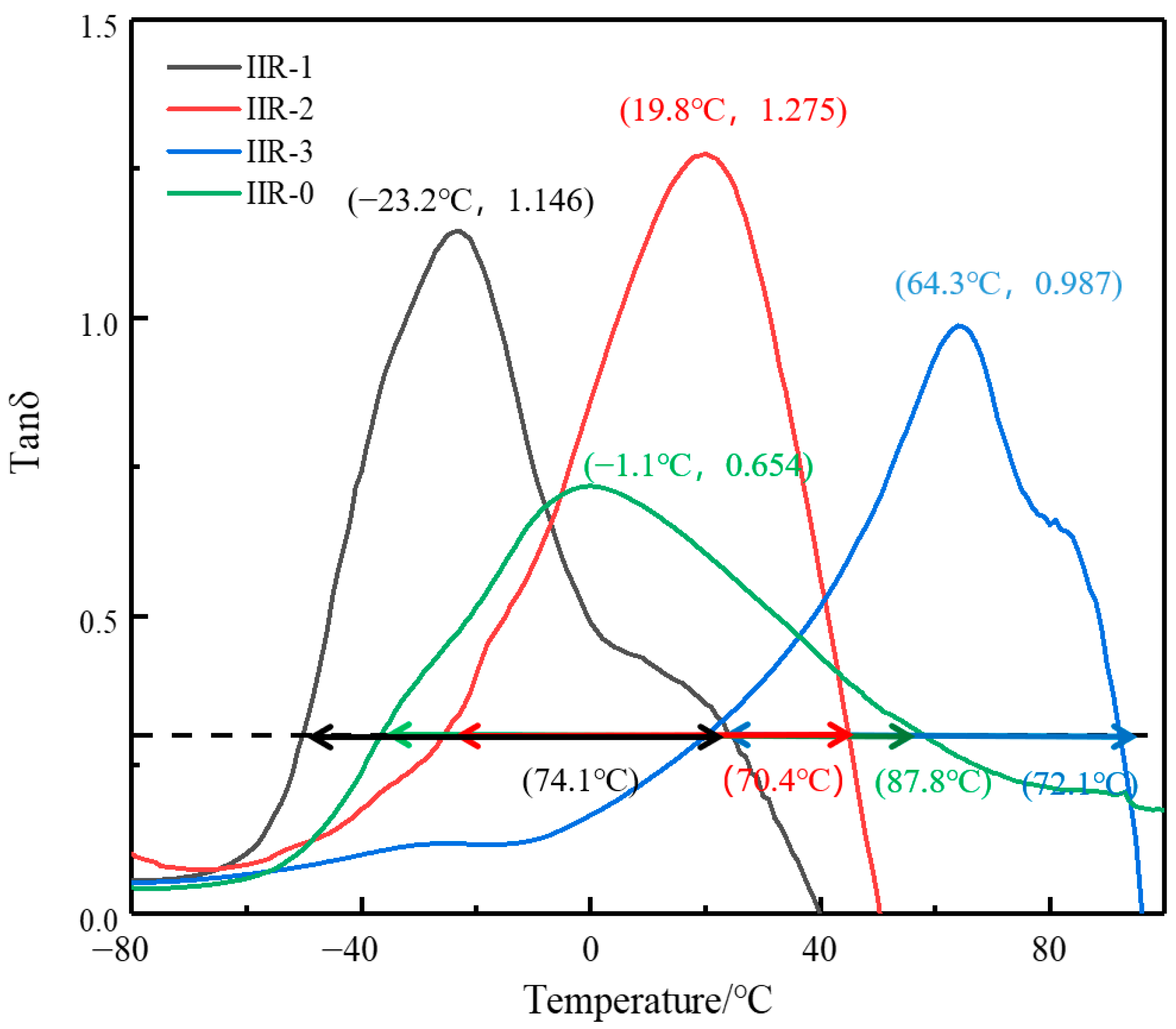



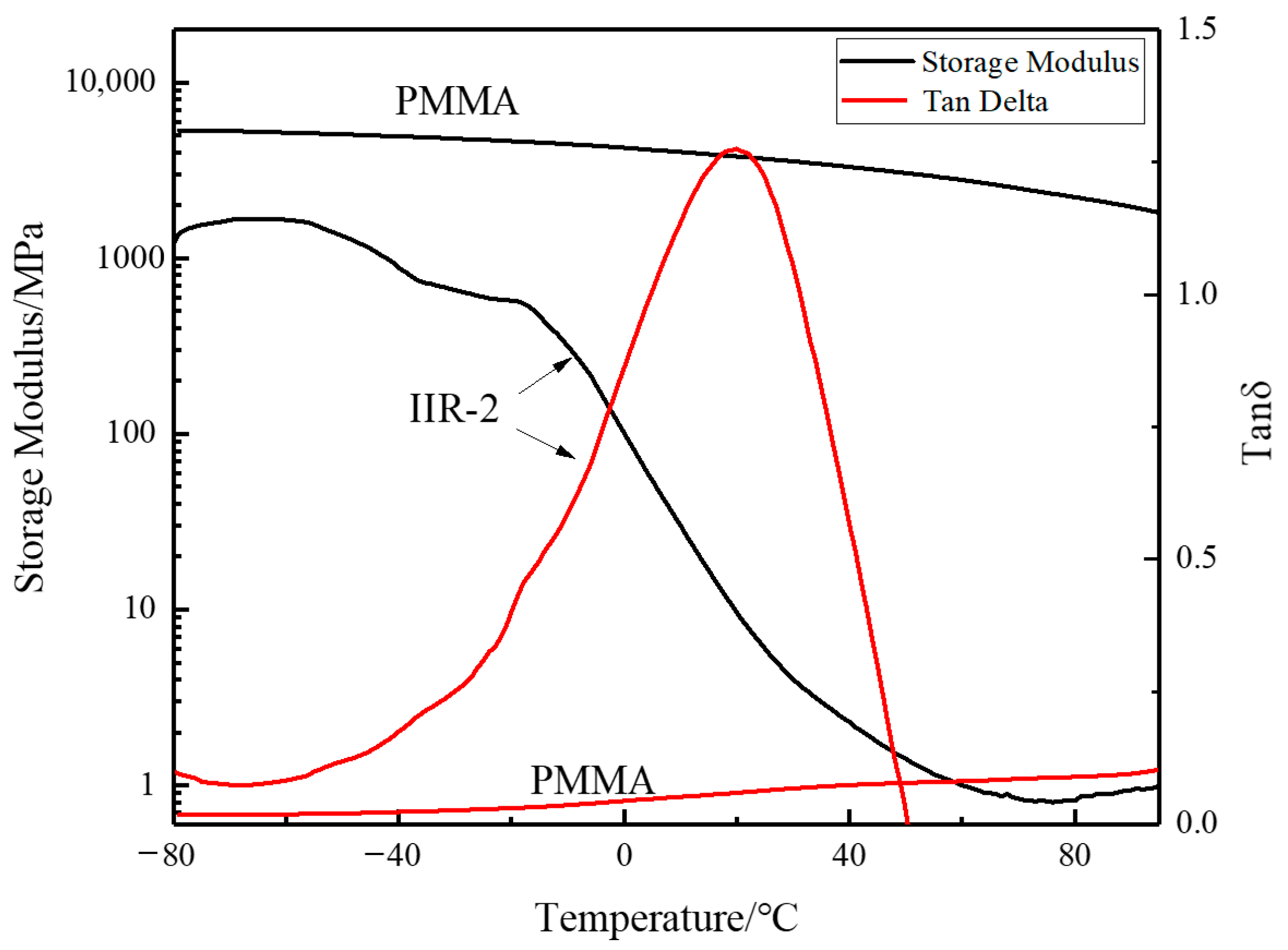
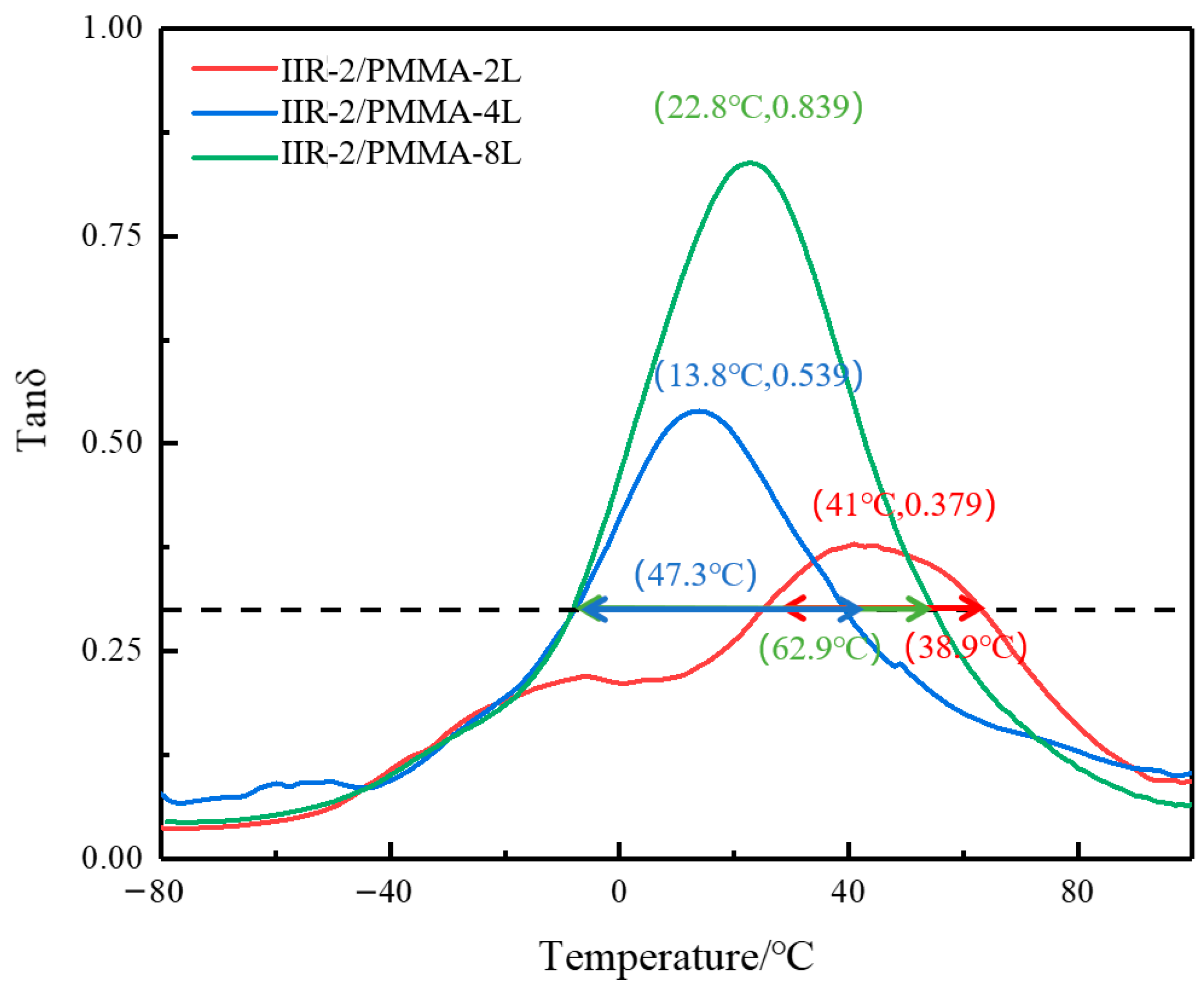

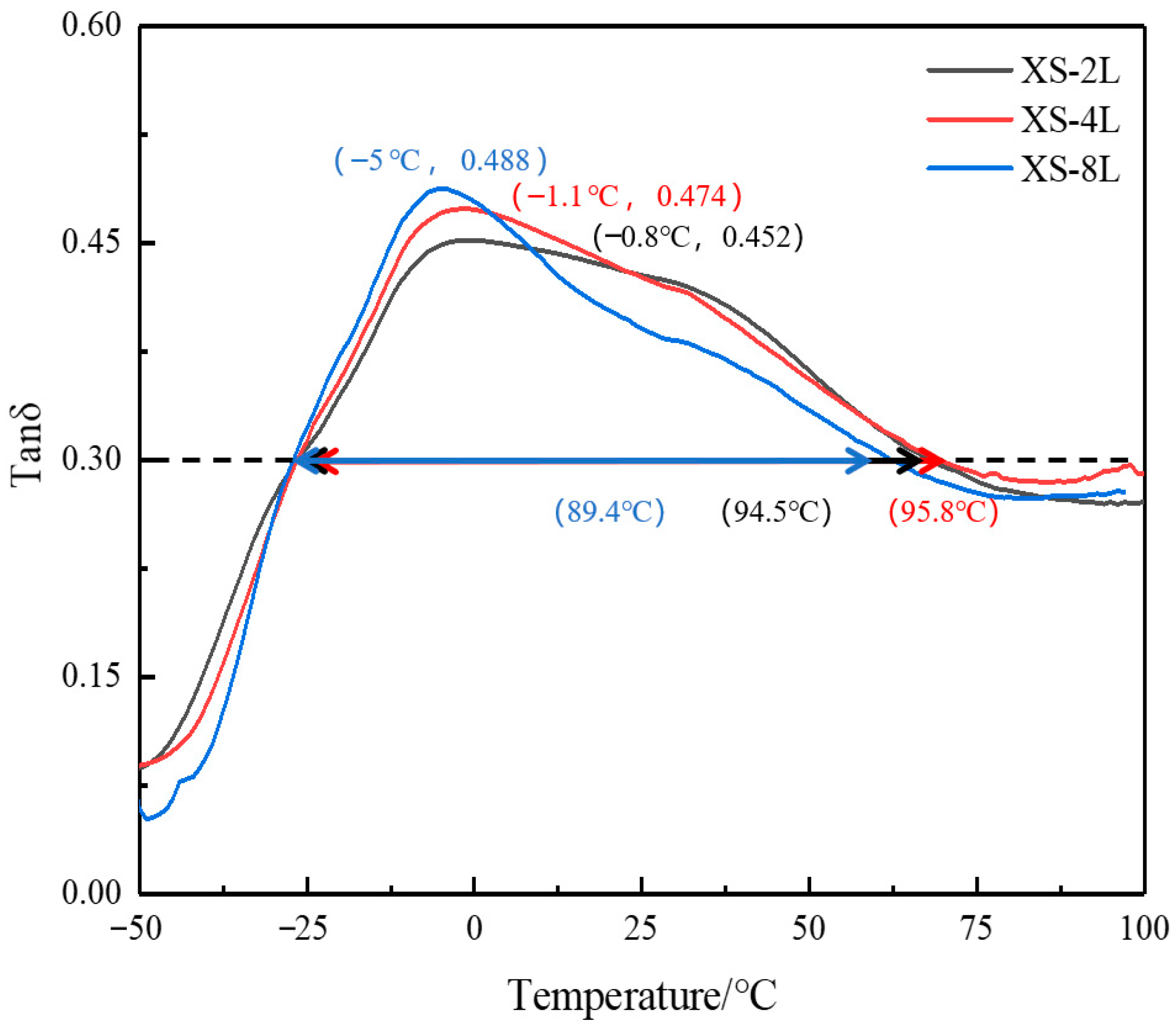
| Sample | IIR | PIB-2400 | CaCO3 | P125 | EG |
|---|---|---|---|---|---|
| IIR-0 | 100 | 100 | 100 | 70 | 80 |
| IIR-1 | 100 | 100 | 100 | / | / |
| IIR-2 | 100 | 100 | 100 | 80 | / |
| IIR-3 | 100 | 100 | 100 | 240 | / |
| Sample | Layered Structure |
|---|---|
| IIR-2-2L | IIR-2/IIR-2 |
| IIR-2-4L | IIR-2/IIR-2/IIR-2/IIR-2 |
| IIR-2-8L | IIR-2/IIR-2/IIR-2/IIR-2/IIR-2/IIR-2/IIR-2/IIR-2 |
| Sample | Layered Arrangement |
|---|---|
| IIR-2/PMMA-2L | IIR-2/PMMA |
| IIR-2/PMMA-4L | IIR-2/PMMA/IIR-2/PMMA |
| IIR-2/PMMA-8L | IIR-2/PMMA/IIR-2/PMMA/IIR-2/PMMA/IIR-2/PMMA |
Publisher’s Note: MDPI stays neutral with regard to jurisdictional claims in published maps and institutional affiliations. |
© 2022 by the authors. Licensee MDPI, Basel, Switzerland. This article is an open access article distributed under the terms and conditions of the Creative Commons Attribution (CC BY) license (https://creativecommons.org/licenses/by/4.0/).
Share and Cite
Qin, C.; Feng, Q.; Zhang, J.; Li, J.; Guo, S. Influence of Alternating Multi-Layered Design on Damping Characteristics of Butyl Rubber Composites and a New Idea for Achieving Wide Temperature Range and High Damping Performance. Polymers 2022, 14, 5484. https://doi.org/10.3390/polym14245484
Qin C, Feng Q, Zhang J, Li J, Guo S. Influence of Alternating Multi-Layered Design on Damping Characteristics of Butyl Rubber Composites and a New Idea for Achieving Wide Temperature Range and High Damping Performance. Polymers. 2022; 14(24):5484. https://doi.org/10.3390/polym14245484
Chicago/Turabian StyleQin, Chao, Qiang Feng, Jie Zhang, Jiang Li, and Shaoyun Guo. 2022. "Influence of Alternating Multi-Layered Design on Damping Characteristics of Butyl Rubber Composites and a New Idea for Achieving Wide Temperature Range and High Damping Performance" Polymers 14, no. 24: 5484. https://doi.org/10.3390/polym14245484
APA StyleQin, C., Feng, Q., Zhang, J., Li, J., & Guo, S. (2022). Influence of Alternating Multi-Layered Design on Damping Characteristics of Butyl Rubber Composites and a New Idea for Achieving Wide Temperature Range and High Damping Performance. Polymers, 14(24), 5484. https://doi.org/10.3390/polym14245484





